#Disque World
Explore tagged Tumblr posts
Text
Ndox Electrique - Tëdd ak Mame Coumba Lamba ak Mame Coumba Mbang - "FeministIndustrialAvantRockEthnoTechnoSauvagerie" duo Putan Club in collaboration with n'doëp musicians from Senegal
Ndox Electrique results from the collaboration between François R. Cambuzat, Gianna Greco (also known for their work with Ifriqiyya Electrique), and the n'doëp community in Senegal. The project originated from the duo's quest to trace the origins of North African rituals, which led them to the Lebu community in Cap-Vert, an isolated region at Africa's westernmost point. The album seamlessly blends the duo's electronically-infused avant-rock with the intense, ritualistic vocal chants and rhythmic percussion of the n'doëp ceremony. It serves as a captivating bridge between these two musical worlds, capturing the essence of this cross-cultural collaboration. The text also highlights the challenges of merging Western rock and experimental influences with the sensibilities of their Senegalese collaborators, ultimately resulting in a unique and powerful musical experience. "Ndox Electrique" transcends cultural boundaries, immersing listeners in the enchanting sounds and mystical narratives of Western Africa. Rokhaya “Madame” Diène : lead vocal Adjaratou "Oumou" Diène : choir Mar Faye : mbëng-mbëng drums Ndiaga Mboup : tunguné & tama drums Abdou Seck : thiol & talmbath drums Gianna Greco : bass, choir, computer & videos François R. Cambuzat : guitars, choir, computer & videos Choir of the “Fanal de la langue de Barbarie” : Rokhaya Mbaye Gamou Dieng Fatou Aladji Mbaye Ousmane Ba : Fulani flute tambing. Abdoulaye Ndiaye “Pape Laye” : n’döepkat & spiritual guidance, master healer and guardian of the temple of Rufisque. Photos : Massow Ka & Renaud de Foville. Cover : David Mamie Ethics & politics guidance : Victor Faye Gianna Greco & François R. Cambuzat play on electric travel basses & guitars specially built for far-away journeys by Mattia Maglio.
#Ndox Electrique#n'doëp#senegal#rock#world music#france#italy#les disques bongo joe#2023#Bandcamp#putan club
9 notes
·
View notes
Text

Wednesday 27 September Mixtape 377 “Venusian Ground” Retro Space Electronic Idm Wednesdays, Fridays & Sundays. Support the artists and labels. Don't forget to tip so future shows can bloom.
The Metamorph-The Venusians 00:31
Tangerine Dream-Love on a Real Train - Live 03:18
Sam Gendel-They B All Like 06:10
Edgar Froese-Tropic Of Capricorn 09:42
Jean-Michel Jarre-Descente au village 14:01
D. Lachlan-Terylene 14:23
Comit (ASC)-Under Your Spell 17:17
Binaural Space-Searching Algo 21:19
Araceae-Strange Nostalgia 22:11
Sound Effects Of Death & Horror-Selling Our Destiny 27:56
Warrington Runcorn New Town Development Plan-The View From Halton Castle 30:40
Prairiewolf-Sage Thrasher 33:58
Wave Temples-Glazed Gnostic (End Credits) 36:10
Anchorsong-Common Ground - Azido 88 Remix 36:53
#The Metamorph#Tangerine Dream#Sam Gendel#LEAVING RECORDS#Edgar Froese#Jean-Michel Jarre#Transversales Disques#D. Lachlan#Café Kaput#Comit (ASC)#Auxiliary#Binaural Space#Araceae#Faint#Sound Effects Of Death & Horror#Wormhole World#Warrington Runcorn New Town Development Plan#Castles In Space#Prairiewolf#Wave Temples#Not Not Fun Records#Anchorsong#Azido 88#Tru Thoughts
2 notes
·
View notes
Text
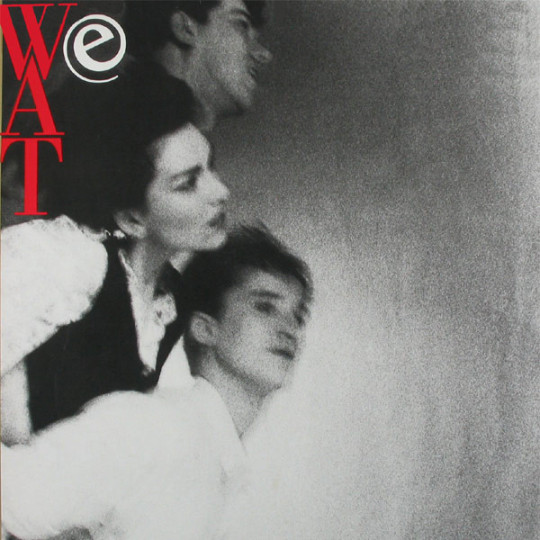
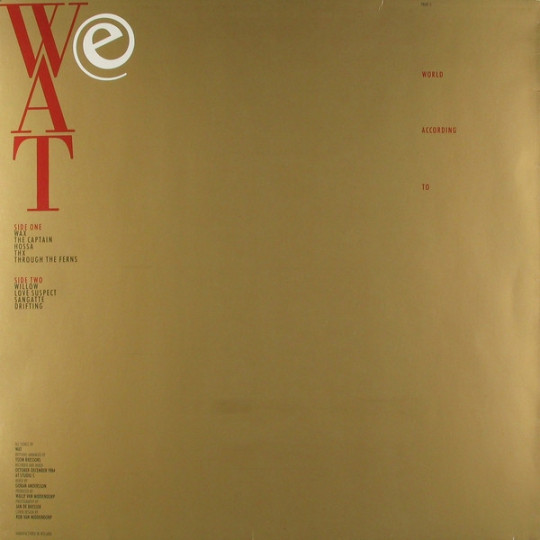
WAT - We (1985)
1 note
·
View note
Text
I wrote a theory for the webcomic The Glass Scientists almost 2 weeks ago. Originally posted in the Disqus comment section underneath last week's update. Before another new page drops on Monday, I figured I might want to share it here on Tumblr, too! If only for my own satisfaction in archiving.
Some small parts aren't quite relevant anymore, I think, but we'll see whether the conclusions hold up, soon. My best guess would be within the next update or two. In the meantime, enjoy!
*******
THEORY TIME!!
I’ve stayed awake one night early last week thinking about what Jekyll could possibly be planning, thoughts swirling. And I think I figured out a solid possibility. Before I get to that, though, I first want to lay down ALL the pieces that brought me to my conclusion. Every piece of supporting evidence I could think of is here.
(Warning: this got pretty long.)
EXHIBIT A:
Whatever he’s planning has to deal with all of what he talked about here:

I want to pay particular attention here to Jekyll conflating his own reputation with that of the Society. In his mind, the two are inseparable. And for good reason, but I’m not about to summarize the whole comic’s events. My point is, his plan HAS to save his, and by extension, the Society’s reputation somehow.
And it doesn’t matter WHAT it takes. He was willing to lock Hyde away (for a few weeks, mind) to save the Exhibition and the Society, after all. SOMEONE had to take the fall for the street fire. He didn’t want to have to do this, but he was pushed into a corner.
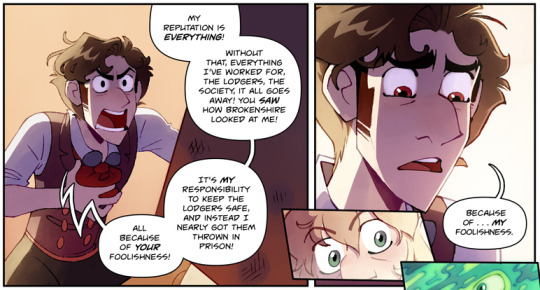
Now, his first plan, when his form became unstable and the sudden transformations started, was to go to his office and search for a spare potion he missed. But that plan is right out the door, cause he scoured the entire place:
Now he’s pushed into a corner again, with the WHOLE Society at stake. If the public finds out Jekyll’s secret, they’re both ruined.
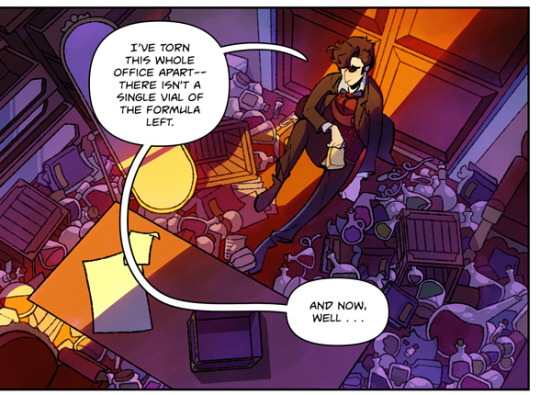
And now?

Only a matter of time until the world finds out his secret.
Time for EXHIBIT B:
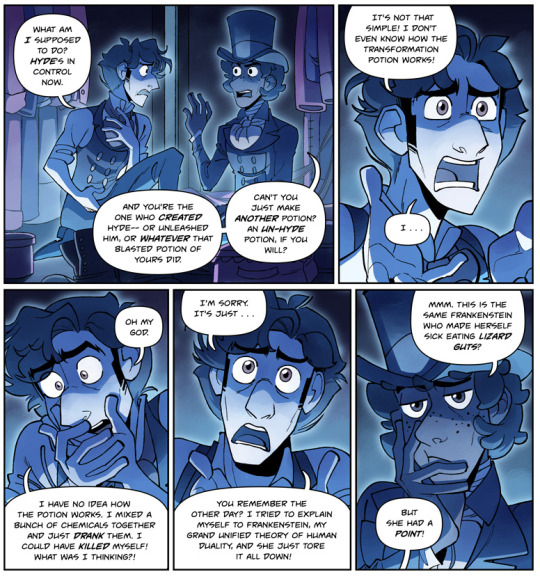
Jekyll’s plan, I think, is unlikely to be an Un-Hyde potion of some sort. He didn’t even know how the original potion worked exactly! And since he doesn’t have any of the old potion left, he probably can’t make a modified version of that either. But, if he still had SOME of the ingredients left, but not all, perhaps he could make a different sort of potion. Perhaps.
But my main point is that I don’t think Jekyll’s plan is a potion to get rid of Hyde. I also think it would be too convenient if he suddenly figured out how to make an Un-Hyde potion that works. On a narrative level, it would be too easy. That’s not his plan. No easy outs for our dear Doctor.
EXHIBIT C:
We know there is going to be a moment that will reflect this chapter’s cover. Sage told us so!

Right here, at the last sentence:

Obviously, it’s not going to be a literal parallel. It’s more about intent, I think. Jekyll is going to do Something, and that Something is NOT going to be good for Hyde. But, and this is key here, it’s not going to be good for Jekyll, either.
They both go down together. I can’t stress this point enough. Jekyll is not planning on coming out of this unscathed. But, remember, his plan HAS to save the Society’s reputation somehow. The world can’t know the truth.
(EDIT: my thoughts on the details of the parallel have evolved since. Now I think it will end up being a lot more literal than I initially thought. See this reply I wrote for more details on that. The key point of this Exhibit remains the same, however.)
EXHIBIT D:

This page feels like Jekyll is saying goodbye, somehow. Not only is he not coming out of this unscathed, I get the strong sense that he’s not planning on coming back at all. Clearly, he doesn’t want to do this. But he feels like he HAS to, for the sake of the Society. He’s resigned to it.
Someone has to take the fall.
Now, you’ve all been reading my reasoning thus far, probably wondering where I’m going with all this. Don’t worry. I only have three exhibits left, and then I will try to bring it all together. Thank you for your patience. I mean it.
EXHIBIT E:
Remember this very interesting bit about how Jekyll and Hyde’s mindscape works?
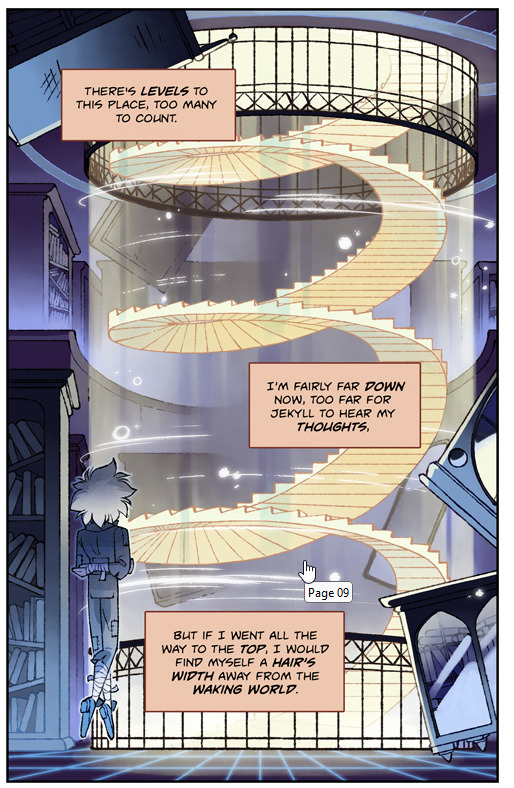
And a moment later, Hyde’s inner monologue says this:
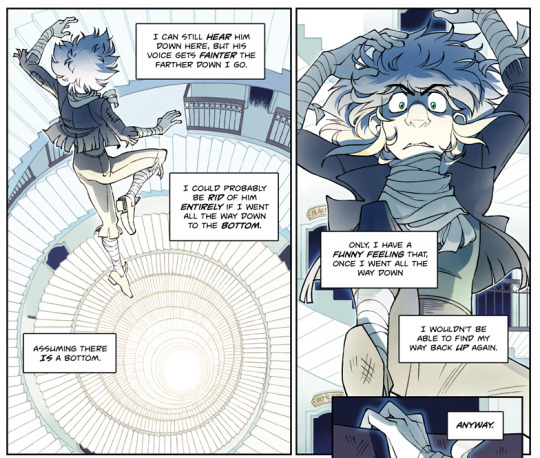
“Only, I have a funny feeling that, once I went all the way down, I wouldn’t be able to find my way back up again.”
You may or may not already see where I’m going with this. :)
EXHIBIT F:
Remember this tweet by Sage? Since I first saw it a year ago, I’ve never forgotten it.
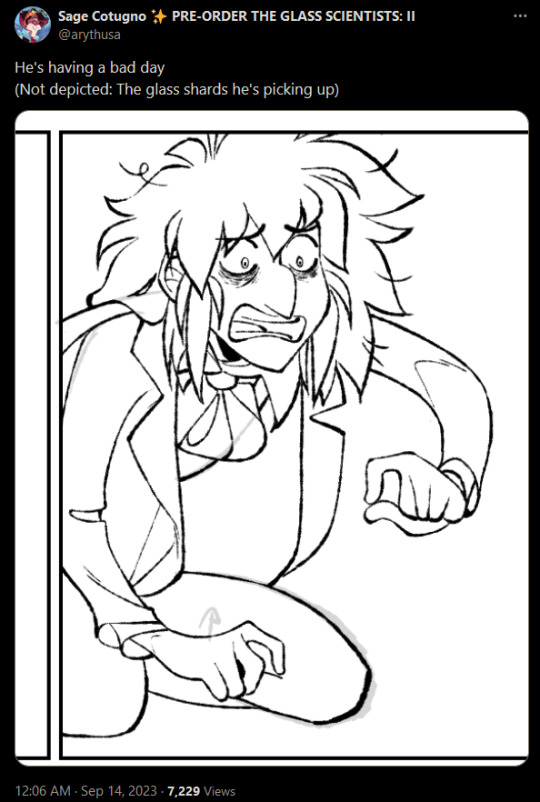
Now, I’ve seen different people theorize whether this is Hyde or Jekyll in Hyde’s body. Well, I’m going to make THREE (hopefully reasonable) assumptions:
1: This is Hyde, not Jekyll in Hyde’s body.
2: This panel will take place in THIS chapter, the one we’re still in, or early in the next.
3: Hyde’s distraught, despairing expression is caused (at least in part) by whatever Jekyll did. His plan.
(There is one more assumption I could state here, but I’ll save it for later. Keep this panel in the back of your mind for a bit if you want.)
And for the FINAL, EXHIBIT G:
Remember the trick Hyde used to force Jekyll to take control again? Forcing a transformation?
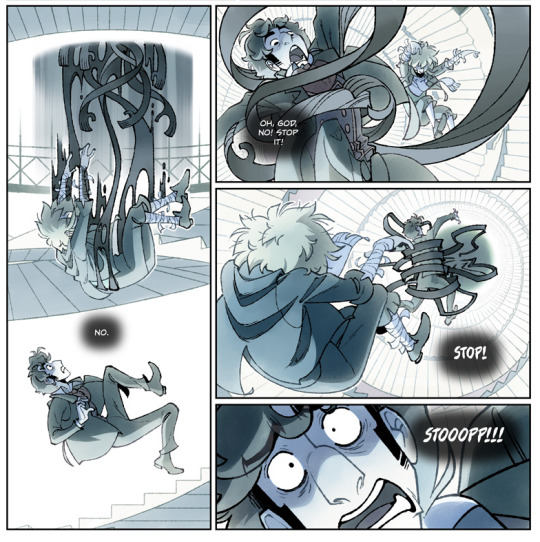
And now, remember THIS PAGE?

It’s probably safe to assume that this, too, works both ways. :)))
And NOW? I’ve run out of exhibits! Well! Well well well!!
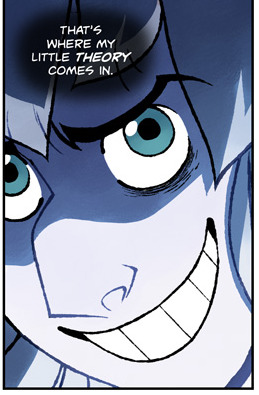
(This panel is not relevant, I just wanted to use it. :D for fun!)
(Also, thank you so much to anyone who’s read this far?? Seriously! This thing is way longer than I planned!!)
My theory is that, quite simply, Jekyll is going to sacrifice himself to save the Society. To save his reputation, and thus, the Society’s.
I don’t think he can get rid of Hyde. But he doesn’t have to. He just needs to preserve his secret, because nobody in the overall public can know that Jekyll and Hyde are the same.
And in order to do that, his form needs to be stable. Remember Exhibit A? The big secret is in danger because he keeps transforming back and forth with no volition. Well, he’s got a solution for that.
Jekyll just needs to let Hyde take control. Permanently.
How? By going into the deepest parts of their mindscape, forcing Hyde to be at the front. Never to be seen again, never to return. His secret will disappear with him.
In order to “stabilize” their form, their body, and stop the sudden transformations, Jekyll doesn’t have to get rid of Hyde. He most likely can’t. But he can get rid of himself. He can certainly try, at least.
If Hyde will never stop fighting Jekyll, then he just needs to let him "win."
More than that, he can let Hyde take the fall for his own disappearance. Remember the will Lanyon found?
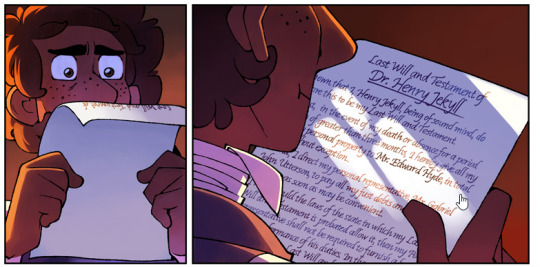
Lanyon straight up thought Hyde was blackmailing Jekyll because of this!
Picture it. In the public eye, if Jekyll disappears, or thought to have been murdered, and it looks like Hyde’s fault, that’s just unfortunate! Jekyll would simply be an innocent victim! Hell, the public might be inclined to show the Society sympathy because of it.
No secrets revealed, no ruined reputations. Hyde goes to prison, and that’s that. The Society itself is saved. All at the cost of both Jekyll and Hyde. And a good leader would do whatever is necessary…right?
The End.
This is Jekyll’s final, desperate gambit. And that’s my theory.
One final bit. See it as an afterword!
Lanyon seems about to rush in and try to stop Jekyll from whatever he’s doing in the office. But me, I think it’s already too late.
When he runs in there, all he’ll see is Hyde, and, perhaps, a broken mirror.
(That’s the other assumption I’m making about the panel with what’s supposed to be Hyde picking up glass shards. Just picture the drama of it all!!)
AND THAT’S ALL, FOLKS!!! Thank you for reading!!! :DDDDD
I’d love to hear what others think! What did I miss? What do you agree, or disagree, with? Feel free to tell me all of it! I love discussing what might happen next!!
EDIT: There is now an Addendum to this theory where I clarify some things I plain forgot to when I first posted it. PLUS, there's an EXTRA Exhibit I came up with later! Link to the comment here, in case it might get lost in the replies.
*******
That's where the original post ends! I'd like to say one more thing. I already addressed this in the Addendum, but I'd like to state it here too: this is ONLY a theory for what Jekyll's plan is. That was my intent, anyway.
By that I mean, I think this plan would FAIL in reality, in several key ways. Mainly, I think Lanyon and the others are going to intervene before Hyde would actually get arrested. Together, they may work to find a solution to both bring Jekyll back (if he's already deep in the unconscious) AND to keep their secret safe. I have hope they'd figure it out!
I'm also planning to post a more general thematic analysis of the whole comic, soonish. With a particular focus on the character arcs of Jekyll and Hyde. Look out for that! I'm still working it out, but it should be done sometime next week.
After that's done, I'm going to share my theories for how I ACTUALLY think the comic might end. Cause I sure as heck don't think it will end as I described above.
That's all! Thanks for reading!! :DDDDD
48 notes
·
View notes
Text
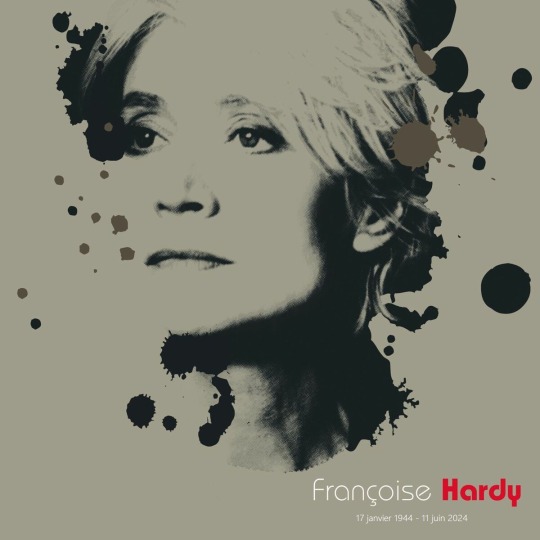
Miss Françoise (17 janvier 1944 - 11 juin 2024)
Miss Françoise Hardy, whose elegance and beautifully lilting voice made her one of France’s most successful pop stars, has passed away today.
She was born in the middle of an air raid in Nazi-occupied Paris in 1944, and raised in the city, mostly by her mother. Aged 16, she received her first guitar as a present and began writing her own songs, performing them live and auditioning for record labels. In 1961, she signed with Disques Vogue.
Inspired by the French chanson style of crooned ballads as well as the emerging edgier styles of pop and rock’n’roll, Miss Hardy became a key part of the yé-yé style that dominated mid-century French music.
The self-penned ballad Tous les garçons et les filles was her breakthrough in 1962, and sold more than 2.5m copies; it topped the French charts, as did early singles Je Suis D’Accord and Le Temps de L’Amour.
Her growing European fame meant she began rerecording her repertoire in multiple languages, including English. Her 1964 song All Over the World, translated from Dans le Monde Entier, became UK Top 20 hit, her fame endured in France, Italy and Germany.
In 1968, Comment te Dire Adieu, a version of It Hurts to Say Goodbye (originally made famous by Vera Lynn) with lyrics by Serge Gainsbourg, became one of her biggest hits.
Miss Hardy’s beauty and deft aesthetic – which encompassed cleanly silhouetted tailoring alongside more casual looks, including knitwear and rock-leaning denim and leather – defined the seeming effortlessness of 20th-century French cool.
She became a muse to designers including Yves Saint Laurent and Paco Rabanne, and was also a frequent subject for fashion photography, shot by the likes of Richard Avedon, David Bailey and William Klein. Later, designer Rei Kawakubo would name her label Comme des Garçons after a line in a Hardy song.
Miss Hardy was an object of adoration to many male stars of 60s pop including the Rolling Stones and David Bowie. Bob Dylan wrote a poem about her for the liner notes of his 1964 album Another Side of Bob Dylan, beginning: “For Françoise Hardy, at the Seine’s edge, a giant shadow of Notre Dame seeks t’ grab my foot …”
She was also courted by directors, appearing in films by Jean-Luc Godard, Roger Vadim, John Frankenheimer and more.
Miss Hardy signed a three-year deal with Sonopresse in 1970. This creatively rich period saw her record with Brazilian musician Tuca on 1971’s highly acclaimed La Question, and continue her multi-lingual releases.
She spent the mid-1970s chiefly focused on raising her son Thomas with her partner, musician and actor Jacques Dutronc. Releases restarted with 1977’s Star, and Hardy embraced the sounds of funk, disco and electronic pop. A longer hiatus in the 1980s was punctuated by 1988’s Décalages, billed as her final album, though she returned in 1996 with Le Danger, switching her palette to moody contemporary rock.
She released six further albums, ending with Personne D’Autre in 2018.
Miss Hardy also developed a career as an astrologer, having written extensively on the subject from the 1970s onwards. In addition, she worked as a writer of both fiction and non-fiction books from the 2000s. Her autobiography Le désespoir des singes... et autres bagatelles was a best-seller in France.
She remains one of the best-selling singers in French history, and continues to be regarded as an iconic and influential figure in both French pop and fashion. In 2006, she was awarded the Grande médaille de la chanson française, an honorary award given by the Académie française, in recognition of her career in music.
Miss Hardy had lymphatic cancer since 2004, and had undergone years of radiotherapy and other treatments for the illness. In 2021, she had argued in favour of euthanasia, saying that France was “inhuman” for not allowing the procedure.
Rest in Power !
#art#music#françoise hardy#rip#rip françoise hardy#astrology#singer#writer#movies#legend#euthanasia#pop star#star#ballad#bob dylan#mick jagger#david bowie#paco rabanne#courreges#jacques dutronc#thomas dutronc#tuca#richard avedon#jean-marie perrier
43 notes
·
View notes
Note
Random thought after a sleepless night: Before disqus got nuked there was some discussion about who gets the medal of the worst parent in Unsounded. Far as I can remember nobody guessed back then that the Bird would have won that award by default, in perpetuity. And if not for all time, (for there are still the Makers and the First World), then for majority of recorded human history for sure...
Weeeeeeeeeeeeeeeeeeell~~
Isn't Lady Ilganyag moving heaven and earth for the sake of her first daughter and son? She's done so much to get them living bodies again. That's some pretty impressive motherhood!
But Sette Frummagem? Not her daughter. Not meaningfully. Sette Frummage's ma was drowned soon after she was born by Sette Frummagem's da. Sette Frummagem is not really her daughter in any way that matters. First Sette though? She's dead, she's kinda crazy, but she's HERS. And it looks like Lady Ilganyag is eager to do anything for her that she wants.
Seems like a good mother to me :3
37 notes
·
View notes
Text

Quincy Jones
Musician, producer and arranger who had global hits with Michael Jackson, was the first black composer to find acceptance in Hollywood and won 28 Grammys
From the 1980s onwards, Quincy Jones, who has died aged 91, was best known for his production and arranging work with Michael Jackson, not least because his efforts on Jackson’s album Thriller helped make it one of the bestselling albums in pop history. But the superstar glare surrounding his work with Jackson tended to conceal the fact that there were many more layers to Jones’s abilities.
He worked with jazz stars such as Count Basie and Dizzy Gillespie, became a friend and collaborator of Frank Sinatra, and developed a flourishing career as a composer of soundtracks for film and TV. He enjoyed success under his own name in styles ranging from big-band jazz and swing to pop, soul and funk. He became an influential music business executive, a successful entrepreneur in film and TV production and launched the music magazine VIBE.
He was born in Chicago, the son of Quincy Jones Sr, a carpenter and semi-pro baseball player, and his wife, Sarah (nee Wells), a building manager. His parents divorced, Quincy Sr remarried, and the family moved to Bremerton, Washington, during the second world war, then to Seattle. Quincy Jr began playing the trumpet and singing in a gospel quartet at the age of 12, and when he met up with the teenaged Ray Charles, also based in the Seattle area, Charles encouraged him to take an interest in arranging. A course at the Berklee College of Music in Boston set Jones up for his first professional job, in 1951, with the bandleader Lionel Hampton.
His experiences on the road with the Hampton band were an eye-opener. “You couldn’t stay in white hotels, and to me, coming from Seattle, a lot of this stuff was like a slap in the face,” he said. “Back then, all the black bands had white bus drivers so they could eat, ’cos you couldn’t go into white restaurants. Even in Philadelphia, they had segregated hotels.” Jones left Hampton in 1953, having accompanied the band on a European tour and rubbed shoulders with a remarkable lineup of musicians including the trumpeters Clifford Brown and Art Farmer.
He set about making a living writing arrangements for jazz luminaries including Basie and Tommy Dorsey. Although Jones put in a stint as musical director for Gillespie’s ensemble in 1956, he was aware that the days of the big bands were numbered, and rock’n’roll was coming. “In a funny way, Lionel Hampton was one of the bands that was serious with a rock’n’roll sensibility, before we even knew what the word meant,” Jones said.
During 1957 and 1958, Jones based himself in France and Scandinavia. He continued to study composition – notably with Nadia Boulanger, mentor of Leonard Bernstein and Aaron Copland, among others – and took a job with Barclay Disques, the Paris-based subsidiary of Mercury Records. While in Europe he formed a star-studded big band of his own, and spent two years touring Europe and the US. He wrote material for Count Basie, and during the late 1950s and early 60s worked as an arranger and music director on recording sessions for vocalists including Billy Eckstine, Ella Fitzgerald, Dinah Washington and Sarah Vaughan.
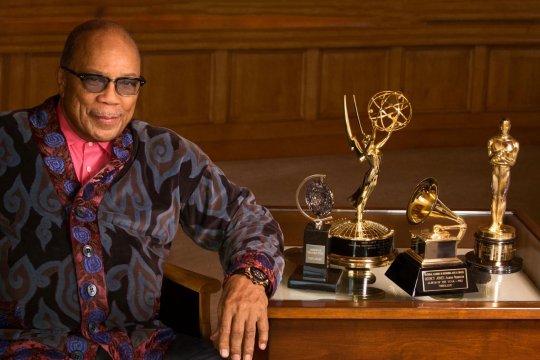
In 1964, Jones won his first Grammy award, for his arrangement of Basie’s song I Can’t Stop Loving You. He also produced four million-selling singles for Lesley Gore, including the US chart-topper and UK Top 10 hit It’s My Party (1963). His hectic career was matched by an equally eventful private life. In his memoir Q: The Autobiography of Quincy Jones (2001), he described how at one point he was dating five women at the same time.
His burgeoning profile was boosted by collaborations with Sinatra, Sammy Davis Jr and Andy Williams. Jones’s association with Sinatra produced the albums It Might As Well Be Swing (1964) and Sinatra at the Sands (1966), both featuring Basie’s band. Jones and Sinatra became close friends, Jones later writing that Sinatra was “hip, straight up and straight ahead, and above all, a monster musician”.
Jones’s track record gained him entry into the lucrative fields of film and television, and he became the first black composer to find acceptance within Hollywood. Throughout the late 60s and 70s he was commissioned to write scores for more than 30 movies and hundreds of TV shows. Among his better-known film projects are In Cold Blood (1967), In the Heat of the Night (1967), The Italian Job (1969) and The Getaway (1972). The theme from Ironside is his most instantly recognisable effort for the small screen, but his compositions for The Bill Cosby Show, Sanford and Son and his Emmy-winning work for the miniseries Roots proved enduringly popular.
As the 70s wore on, Jones displayed his instinct for moving with prevailing musical trends by immersing himself in funk and disco music. His album Body Heat, from 1974, featured the Brothers Johnson as the rhythm section, and Jones subsequently produced bestselling albums by the Brothers Johnson themselves.
Despite undergoing surgery to deal with twin brain aneurysms in 1974, Jones continued to work at a furious pace. He produced chart-busting albums for the disco queen Donna Summer and soul diva Aretha Franklin, and he found another musical soulmate in the guitarist George Benson. Their collaboration on Give Me the Night (1980) – the debut release on Jones’s Qwest label – was another career benchmark, the album reaching No 3 on the US album chart while the title track was a No 4 single.
Meanwhile Jones had hits under his own name. He had a US Top 30 success with Stuff Like That (1978), and in 1981 scored a Top 10 album with The Dude, which spun off the Top 30 hit Ai No Corrida (No 4 in the UK), and the Top 20 hits Just Once and One Hundred Ways, both featuring James Ingram. In 1998, the hit movie Austin Powers prompted a revival of Quincy’s 1962 hip-shaker, Soul Bossa Nova; it was also used as a theme for the 1998 football World Cup in France.
Jones first met Michael Jackson, then aged 12, at Davis Jr’s house, but it was not until Jones was working on the soundtrack for the film The Wiz (1978), starring Jackson and Diana Ross, that he was invited to produce a Jackson solo album. This was the 20m-selling Off the Wall (1979). Their collaboration continued with Thriller (1982) and Bad (1987), the trio selling 100m copies between them. In between, Jones was also the natural choice to produce the 1985 charity single, We Are the World, co-written by Jackson and Lionel Richie and performed by the all-star USA For Africa to benefit Ethiopian famine victims.
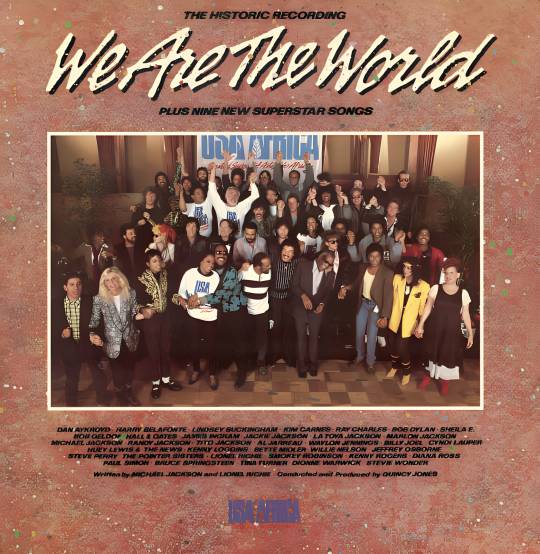
Jones was a pivotal figure in helping musicians take control of the business side of their work. Like most other musicians, he had grown accustomed in the early years of his career to having his royalties and copyrights appropriated by unscrupulous publishers or record labels. “If you write a song, the publishing is 50% of that,” Jones explained. “They would say: ‘I want 50% of your creation’, so that means you get 25%. That was normal.” He began to see the light when he took a job as A&R man at Mercury Records in New York in 1961. Within two years, he was made a vice-president, making him the first high-level black executive of a major record label. “I’d lost so much money when I had my band [the Jones Boys] in Europe that I had to go with a record company. That’s when I said: ‘I’d better pay attention to the other side, because it is a music business.’”
After moving from Mercury to A&M Records he launched Qwest, which became home to such varied artists as New Order, Milt Jackson, the Winans and Tevin Campbell. Qwest also did excellent business with the soundtracks to Malcolm X (1992) and the rap-generation movie Boyz N the Hood (1991).
Growing into the role of entertainment mogul, Jones co-produced Steven Spielberg’s film of The Color Purple in 1985 and produced its soundtrack. In 1990 he teamed up with Time Warner Inc to form Quincy Jones Entertainment; in 1991 he helped create the NBC television series The Fresh Prince of Bel Air, which launched Will Smith on the road to superstardom; and in 1993 he set up VIBE. He headed a consortium of businessmen that formed Qwest Broadcasting, which purchased TV stations in Atlanta and New Orleans.
Jones won an Emmy, 28 Grammys and three Special Grammy awards, including the Grammy Legend award in 1992, was given the Sammy Cahn lifetime achievement award from the Songwriters Hall of Fame in 1989, and was inducted into the Rock & Roll Hall of Fame in 2013. He was showered with honorary doctorates, Time magazine declared him one of the most influential jazz musicians of the 20th century, and in 1990 he was made a chevalier of the Légion d’honneur, promoted to commander in 2001.
He was celebrated in the film Listen Up: The Lives of Quincy Jones (1990) and the documentary Quincy (2018), directed by his daughter Rashida.
Three marriages ended in divorce. He is survived by a daughter, Jolie, from the first, to Jeri Caldwell; a daughter, Martina, and son, Quincy, from the second, to Ulla Andersson; two daughters, Rashida and Kikada, from the third, to Peggy Lipton; and by a daughter, Kenya, from a relationship with Nastassja Kinski, and a daughter, Rachel, with Carol Reynolds.
🔔 Quincy Delight Jones Jr, musician, producer, composer and arranger, born 14 March 1933; died 3 November 2024
Daily inspiration. Discover more photos at Just for Books…?
13 notes
·
View notes
Text
LÉGENDES DU JAZZ
JOE ZAWINUL, DE WEATHER REPORT AUX MUSIQUES DU MONDE
“My dad raised the bar in the music world as a true artist to his profession. As a bandleader, he was able to pull out performances from his bandmates and take them to heights they never knew existed. He never compromised his art. You either liked it or you didn’t. One thing is for sure, though, you always knew it was Joe Zawinul.”
- Anthony Zawinul
Né le 7 juillet 1932 à Vienne, en Autriche, Josef Erich Zawinul était d’origine gitane (par sa grand-mère d’origine hongroise) et avait grandi dans une famille musicale. Son père, qui travaillait comme commis pour une compagnie de gas, jouait de l’harmonica pendant ses temps libres. Sa mère était chanteuse. Zawinul avait un frère jumeau, Erich, qui était mort de pneumonie à l’âge de quatre ans.
Zawinul avait d’abord appris à jouer de l’accordéon à l’âge de six ans, un instrument qu’il avait continué d’apprécier durant toute sa vie. La famille Zawinul étant trop pauvre pour avoir son propre piano, les talents de Josef étaient si remarquables que ses parents lui avaient payé des leçons de piano classique. Le Conservatoire de Vienne (Konservatorium Wien) avait été tellement impressionné par les talents de Zawinul qu’il avait accepté de lui donner des cours gratuits de piano, de clarinette, de violon et de composition. Parmi les camarades de classe de Zawinul, on remarquait le pianiste classique Friedrich Gilda. Zawinul avait également formé un duo avec le futur président autrichien Thomas Lentil.
Une des grandes découvertes de Zawinul durant sa jeunesse était le jazz américain, qui avait été interdit par les Nazis durant la Seconde Guerre mondiale. À la fin de la guerre, Vienne ayant été victime de nombreux bombardement alliés, Zawinul et ses vingt-huit camarades de classe avaient été évacués en Tchécoslovaquie, où ils avaient poursuivi leurs études musicales tout en étant soumis à un entraînement militaire plutôt strict sous la direction d’officiers SS blessés. C’est à cette époque que Zawinul avait entendu du jazz pour la première fois lorsqu’un de ses camarades de classe avait interprété une version improvisée du standard “Honeysuckle Rose” au piano. Parmi les premières influences de Zawinul, on remarquait les pianistes Erroll Garner et George Shearing.
Après la guerre, Zawinul était retourné à Vienne où il avait poursuivi ses études de piano classique tout en gagnant un peu d’argent en jouant de l’accordéon avec de petits groupes de danse. Après la fin des hostilités, lors de l’occupation de Vienne par les Alliés, Zawinul avait commencé à jouer sur des bases militaires américaines, ce qui lui avait permis d’avoir accès à un orgue Hammond, un instrument qui l’avait toujours fasciné.
DÉBUTS DE CARRIÈRE
Il n’avait pas fallu longtemps à Zawinul pour lancer sa carrière musicale. Il expliquait: “I saw what I wanted to do with my life, and that was to play with black musicians.” Après avoir travaillé comme pianiste de studio pour les disques Polydor, Zawinul avait accompagné en 1952 le saxophoniste autrichien Hans Keller. Il avait aussi joué avec les Austrian All Stars, le pianiste classique Friedrich Gulda (avec qui il avait fait ses débuts sur disque en 1953), Karl Drewo et Fatty George. Il avait également fait une tournée en Allemagne et en France avec son propre trio. Convaincu que sa carrière ne pourrait se développer davantage en Autriche, Zawinul était tellement obsédé par l’idée d’aller jouer aux États-Unis que certains de ses amis musiciens avaient arrangé un faux appel téléphonique l’invitant à se joindre au groupe d’Ella Fitzgerald en tournée ! Après avoir découvert la vérité, Zawinul avait par la suite raté une occasion en or en ignorant un autre appel (mai bien réel celui-là) du trompettiste Clark Terry.
Zawinul avait finalement obtenu sa chance après avoir vu une publicité de la Berklee School of Music dans un des rares exemplaires du magazine Down Beat à avoir réussi à se rendre jusqu’à Vienne. Après avoir remporté une bourse pour aller étudier durant un semestre à Berklee, Zawinul s’était embarqué sur un navire le 2 janvier 1959 et avait entrepris la traversée de cinq jours jusqu’aux États-Unis. Avec seulement 800$ en poche, Zawinul savait que sa tâche ne serait pas facile. Comme il l’avait précisé plus tard, “I knew that it wouldn’t be easy, because I had no relatives, didn’t know a single person in America. But when I came over on the boat, I did it with the purpose to kick asses.”
À son arrivée à New York, Zawinul avait fait un de ses premiers arrêts au célèbre club Birdland, où il était entré en contact avec la scène du jazz pour la première fois. C’est d’ailleurs au Birdland que Zawinul avait rencontré sa future épouse Maxine.
Mais les événements n’avaient pas tardé à se bousculer. Quelques semaines après avoir commencé à étudier à Berklee, un des professeurs de Zawinul lui avait proposé d’agir de remplacer un pianiste dans le cadre d’une performance avec le bassiste Gene Cherico et le batteur Jake Hanna. Impressionné par le talent de Zawinul, Hanna l’avait recommandé au trompettiste canadien Maynard Ferguson qui l’avait embauché peu après lui avoir fait passer une brève audition. Ferguson avait aussi auditionné quelques saxophonistes, car son saxophoniste régulier venait de quitter le groupe. Parmi les candidats, on remarquait un jeune saxophoniste appelé Wayne Shorter. C’est ainsi que la longue et fructueuse collaboration de Zawinul et Shorter avait débuté.
Ne pouvant laisser passer cette occasion en or, Zawinul avait fait ses adieux à Berkley et avait joué en tournée durant huit mois avec Ferguson, participant notamment à l’enregistrement de l’album live A Night at Birdland. Après avoir joué brièvement avec le tromboniste Slide Hampton, Zawinul avait accompagné la chanteuse Dinah Washington durant trois ans (1959 à 1961), ce qui lui avait permis de se familiariser avec le blues et de collaborer à l’enregistrement de l’album à succès “What A Diff’rence a Day Makes!” Washington voyageant souvent en tournée avec Ray Charles, Zawinul utilisait souvent le piano électrique Wurlitzer de ce dernier lorsque le piano acoustique des salles dans lesquels il était appelé à jouer n’était pas en parfait état. C’était la première fois de sa carrière que Zawinul se servait d’un piano électrique, mais ce ne serait sûrement pas la dernière. Mais même s’il avait apprécié de jouer avec Washington, accompagner une chanteuse n’était pas vraiment l’objectif de Zawinul dans la vie. Le rêve de Zawinul était de devenir un musicien de jazz à part entière, et il savait que pour réaliser son ambition, il devait passer à autre chose. Après avoir quitté Washington, Zawinul était parti brièvement en tournée avec Harry ‘’Sweets’’ Edison et Joe Williams.
À l’automne 1961, Zawinul avait finalement été invité à se joindre au quintet de Cannonball Adderley, qui était alors un des groupes les plus renommés du jazz. En 1961, Zawinul avait inauguré une collaboration de neuf ans avec Adderley, dont le style de jeu était très influencé par le soul et d’autres formes de musique afro-américaine. Adderley, après avoir remarqué la facilité avec laquelle Zawinul était capable d’absorber ces styles de musique, l’avait encouragé à composer. Devenu progressivement le principal compositeur du groupe, Zawinul, qui avait écrit le grand succès de 1966 “Mercy, Mercy, Mercy” ainsi que d’autres pièces à succès du saxophoniste comme ‘’Walk Tall" et "Country Preacher". C’est à la même époque que Zawinul s’était lié d’amitié avec le pianiste Herbie Hancock. Saluant la remarquable habileté de Zawinul à saisir l’esprit du peuple afro-américain, Hancock avait déclaré plus tard au sujet de Zawinul: "For a white Viennese boy to write a tune that's that black is pretty remarkable. He just captured the essence of the African-American heritage, just the statement of melody and feeling of that song. Clearly, in some past life, Joe must've been black."
Zawinul avait également composé pour Adderley des pièces plutôt innovatrices comme “74 Miles Away” et “Rumpelstiltskin”. En tout et pour tout tout, Adderley avait enregistré une cinquantaine de compositions de Zawinul.
Durant cette période, Zawinul avait également trouvé le temps d’enregistrer deux albums comme leader, Money In the Pocket (1966) et The Rise and Fall Of The Third Stream (1967).
Le solo de Zawinul sur “Mercy, Mercy, Mercy” représentait une des premières utilisations du piano électrique dans un enregistrement de jazz. Zawinul avait écrit la pièce lors de sa collaboration avec la chanteuse de gospel Esther Marrow. Peu avant la session d’enregistrement, Zawinul avait repéré un piano électrique Wurlitzer dans le studio et avait demandé à Adderley s’il pourrait l’utiliser de préférence à un piano acoustique, car il était convaincu que ce changement permettrait de connaître un grand succès. Le flair de Zawinul avait porté fruit, et la pièce s’était hissée à la onzième position du palmarès Billboard. Parallèlement à son séjour avec le groupe d’Adderley, Zawinul avait également accompagné d’autres grands noms du jazz comme le saxophoniste Ben Webster.
Les groupes multi-raciaux n’étant pas encore très nombreux dans le jazz à l’époque, Zawinul devait souvent s’allonger sur le plancher de l’autobus lorsqu’il voyageait en tournée avec le groupe d’Adderley dans les États du Sud. Comme Zawinul l’avait expliqué au cours d’une entrevue qu’il avait accordée en 1997, ‘'I often had to sit in the bottom of the car when we drove through certain parts of the South.’’ Mais, malgré tous ces obtacles, Zawinul avait refusé de se laisser intimider et n’avait jamais abandonné son rêve de devenir un musicien de jazz respecté. Il avait ajouté: ‘’Those kinds of things never fazed me; I wanted to play music with the best, and I could play on that level with the best.''
La collaboration de Zawinul avec Adderley avait été significative tant sur le plan musical que personnel. Les membres du groupe d’Adderley passaient énormément de temps ensemble lors des tournées, ce qui leur avait permis de développer de solides amitiés. Comme Zawinul l’avait raconté plus tard, “He was family. He was my best man, my witness, when I got married. He bought bicycles for my kids. He was a great friend. He was like a brother to me.” Des années après la mort d’Adderley en 1975, il était toujours très présent dans la vie de Zaminul. Comme Zawinul l’avait précisé en 2004: “I miss him every day. My wife and I, we talk about him somehow every day.”
Même s’il avait remporté énormément de succès comme musicien, Zawinul craignait d’être considéré comme un simple imitateur du style des autres plutôt qu’un véritable créateur. Les choses avaient atteint un point de rupture lorsque le pianiste Barry Harris lui avait fait remarquer que le son style de jeu ressemblait à s’y méprendre au sien. Flatté au début, Zawinul avait finalement décidé de ranger sa collection de disques de jazz dans une boîte afin de pouvoir prendre une nouvelle direction. En 1966, Zawinul avait pris de nouveaux cours de piano classique avec Raymond Leventhal. Après sept mois de cours, Leventhal avait déclaré qu’il n’avait plus rien à apprendre à Zawinul et lui avait offert un clavier de pratique en cadeau.
À la fin des années 1960, après s’être marié à Maxine, le premier mannequin afro-américain de l’histoire du magazine Playboy, avec qui il avait eu trois enfants, Zawinul avait reçu une offre tentante du producteur Norman Granz, qui lui aurait permis de réaliser son vieux rêve de jouer avec Ella Fitzgerald. Granz avait proposé à Zawinul un salaire de 1400$ par semaine, ce qui représentait une augmentation de 300$ comparativement à ce qu’il gagnait avec Adderley. Mais à l’époque, Zawinul avait déjà commencé à suivre les traces de Miles Davis et tentait de réaliser une sorte de fusion du rock et du jazz, ce qui lui avait enfin permis de trouver son propre son. Après avoir demandé cinq minutes à Granz pour réfléchir, Zawinul était allé consulter son épouse Maxine qui avait répondu: “No. You do what you have to do. I can make do with $300 and I have time to wait until you have your thing.” Zawinul, qui adorait sa femme, lui avait un jour fait le plus beau compliment qu’un homme pouvait faire à son épouse en déclarant : "I have a great wife. And I believe it takes a great wife to become a great man."
Zawinul avait donc décliné l’offre de Granz et avait commencé à travailler sur une nouvelle série de compositions qui témoignaient de son intérêt pour le jazz-fusion. Quant à Davis, il avait été tellement impressionné par le solo de Zawinul sur la pièce “Mercy, Mercy, Mercy” qu’il allait souvent le voir jouer avec le groupe d’Adderley. Il lui avait même proposé de se joindre à son propre groupe. Lorsque Zawinul avait refusé, Davis avait demandé à son pianiste Herbie Hancock de laisser tomber le piano acoustique en faveur du piano électrique. Fasciné par les compositions de Zawinul, Davis avait également invité ce dernier à participer aux sessions qui allaient donner naissance à l’album In A Silent Way (1960), d’après le titre de la composition du même nom de Zawinul. Au cours de l’année suivante, Zawinul avait continué d’enregistrer avec Davis à de nombreuses reprises. D’autres compositions de Zawinul, dont ‘’Pharaoh's Dance” et “Double Image”, avaient aussi été incluses sur des albums de Davis comme Bitches Brew (1970), Live–Evil (1971) et Big Fun (1974).
Zawinul avait d’ailleurs lui-même fait des apparitions sur ces trois albums même s’il ne s’était jamais joint officiellement au groupe de Davis. Lorsque Zawinul avait publié son premier album solo simplement intitulé ‘’Zawinul’’ en 1970, il avait décliné la proposition de Davis de participer à l’enregistrement sous prétexte que la présence du trompettiste ne pouvait que lui faire de l’ombre. Zawinul avait répondu à Davis: "If you're on the record, your presence will be so powerful I cannot find out what I am worth."
Finalement, Davis avait rédigé les notes de pochette de l’album qui avait été décrit par un critique du magazine Down Beat comme ‘’the work of a complete musician who has transcended categories and is certain to have a profound influence on the direction music will take in the ‘70s.” Zawinul avait joué en public avec Davis seulement une fois, peu avant la mort du trompettiste. Le concert avait eu lieu à Paris le 10 juillet 1991. Wayne Shorter participait également au concert.
WEATHER REPORT
À l’époque de sa collaboration avec Miles Davis, le principal saxophoniste du groupe était Wayne Shorter, que Zawinul connaissait depuis sa collaboration avec le trompettiste Maynard Ferguson en 1959. C’est à cette époque que Zawinul et Shorter avaient commencé à parler de la fondation d’un éventuel groupe. Le contrebassiste d’origine tchèque Miroslav Vitous était également impliqué dans le projet. Zawinul avait expliqué plus tard qu’il envisageait de former un groupe aver Shorter depuis qu’il l’avait entendu jouer sur l’album Nefertiti de Miles Davis en 1968.
Connu sous le nom de Weather Report, le groupe avait été officiellement fondé en décembre 1970 et avait enregistré son premier album éponyme l’année suivante. Très influencée par l’Afrique, l’Amérique latine et le Moyen-Orient, la musique du groupe avait été décrite par Jonathan Herrera du magazine Bass Player comme "a free jazz experiment, a world music pioneer, a jazz-pop blockbuster, and a seriously grooving funk band." Sous contrat avec les disques Columbia, le groupe avait remporté un grand succès dès le départ tant auprès des amateurs de jazz que de la critique, même si l’importance accordée aux instruments électroniques avait irrité certain puristes. Décrivant le premier album du groupe, le critique Dan Morgenstern écrivait dans le magazine Down Beat: ‘’The music of Weather Report is beyond category… music unlike any other I’ve heard, music that is very contemporary but also very warm, very human, and very beautiful… The forecast, if there is justice, must be clear skies and sunny days for these four creative men and their associates.” Rapidement devenu le plus populaire groupe de jazz de son époque, Weather Report avait remporté tous les sondages des lecteurs du magazine Down Beat comme meilleur groupe de jazz durant chacune de ses années d’existence (1970 à 1985).
Il faut dire que le groupe était arrivé au bon moment. À l’époque, les progrès technologiques de l’époque avaient grandement favorisé le développement du groupe, notamment en réduisant la taille de synthétiseurs qui étaient devenus plus faciles à transporter, ce qui les avaient rendus accessibles au plus grand nombre, permettant ainsi de les utiliser dans les sessions d’enregistrement et les performances sur scène.
Zawinul avait acquis son premier synthétiseur en 1971, un Arp 2600 qui lui avait été offert par le fabricant de synthétiseurs Arp afin d’augmenter la crédibilité de la compagnie face à la compétition de son puissant compétiteur Moog Music. Zawinul avait utilisé le Arp 2600 pour la première fois sur le second album du groupe intitulé I Sing the Body Electric, un enregistrement d’un concert au Japon en 1972. Une des pièces de l’album était une composition ambitieuse de Zawinul appelée “Unknown Soldier’’, qui relatait sa jeunesse en Autriche durant la Seconde Guerre mondiale. À l’époque, le rôle du synthétiseur Arp était encore très réduit , et se limitait à produire certains effets sonores. Fasciné par la nouvelle technologie, Zawinul avait commencé à enregistrer ses improvisations sur cassette (et plus tard sur MIDI dans son propre studio maison que son épouse avait surnommé “the Music Room”), qu’il utilisait par la suite comme base de ses compositions (comme sur les pièces “Nubian Sundance” et “Jungle Book” tirées de l’album Mysterious Traveler) ou transcrivait note par note afin que le groupe puisse les exécuter de la façon dont il les avait écrites à l’origine. Zawinul avait utilisé cette méthode tout au long de sa carrière. Décrivant son style de composition, Zawinul avait expliqué: “It is all improvisation. All my tunes are improvisations. I’m a formal improviser. Even my symphony I improvised.”
Au cours de ses deux premières années d’existence, le groupe s’était surtout fait connaître par la qualité de ses improvisations. Même si au début le groupe jouait une musique très apparentée à celle de Miles Davis (mais avec une sonorité un peu plus rock), il avait rapidement commencé à bâtir son propre son.
À partir de la publication de l’album Sweetnighter en 1973, le rôle de Zawinul avec le groupe était devenu de plus en plus important. Après être passé progressivement du piano électrique au synthétiseur, Zawinul avait commencé à exploiter pleinement le potentiel d’un instrument qui avait été jusque-là la chasse-gardée de la musique pop. Il avait aussi ajouté des éléments funk en ajoutant des instruments comme la basse électrique et la pédale wah-wah, ce qui avait permis d’introduire de nouvelles couleurs dans le son du groupe. L’ajout d’un bassiste et d’un batteur spécialisés dans le funk avaient également contribué à atteindre cet objectif.
À la suite de la parution du quatrième album du groupe, Mysterious Traveller, en 1974, le virage du groupe vers une sonorité plus funk s’était encore accentué. L’ajout d’éléments inspirés par la musique classique avait également ajouté de nouvelles couleurs sonores. L’addition du bassiste Alphonso Johnson avait aussi favorisé la transition du groupe vers un son qui intégrait des éléments de jazz et de rock de façon très originale. La combinaison des harmonies du jazz et des éléments funk des années 1970 avait également aidé le groupe à connaître sa période la plus lucrative sur le plan commercial. Pour l’album Black Market en 1976, Zawinul avait recruté le phénomène de la basse électrique Jaco Pastorius. Très sûr de ses moyens, Pastorius s’était présenté lui-même à Zawinul comme “the world’s greatest bass player.” Même s’il est toujours considéré de nos jour comme le plus grand innovateur de l’histoire de la basse électrique, Pastorius avait de nombreux problèmes personnels qui l’avaient éventuellement conduit à sa perte.
Avec Pastorius dans l’alignement, Weather Report avait connu le plus grand succès de sa carrière avec l’album Heavy Weather (1977), qui comprenait la plus célèbre composition de Zawinul, ‘’Birdland’’, écrite en hommage au club du même nom sur la 52e rue de New York. La pièce avait remporté un si grand succès qu’elle s’était hissée jusqu’à la 30e position du palmarès Billboard. Le groupe vocal Manhattan Transfer avait par la suite ajouté des paroles sur la pièce, ce qui avait encore accru sa popularité. Zawinul a d’ailleurs ouvert son propre club Birdland dans sa ville natale de Vienne en Autriche en 2004.
Devenue une des compositions de jazz les plus connues des années 1970, la pièce avait permis à Zawinul de remporter trois prix Grammy et avait été reprise par la suite par de nombreux artistes dont Quincy Jones, Maynard Ferguson, le big band de Buddy Rich et même le groupe rock Jefferson Starship. Décrivant l’album Heavy Weather en 2001 dans le cadre de sa rétrospective de l’histoire du groupe, le critique Jossef Woodard écrivait dans le magazine Down Beat: “In 2000, Heavy Weather still sounds like a milestone in the cultural unconscious of jazz history. By some accounts, the album is the crowning achievement of the band’s recorded output, and therefore, by extension, a towering landmark of fusion.”
L’alignement du groupe ayant souvent fluctué avec les années, Zawinul et Shorter étaient progressivement devenus les deux principaux piliers de la formation. Considérés comme de véritables happenings, les concerts du groupe, tels qu’on peut le constater sur l’album live 8:30 (1979), étaient souvent imprévisibles. Les albums I Sing the Body Electric (1971), Mysterious Traveller (1974) et Night Passage (1980) avaient aussi été très populaires sur la radio FM et auprès des amateurs de jazz, de rhythm & blues et de musique pop.
DERNIÈRES ANNÉES
Même si Weather Report avait continué de publier régulièrement des albums au milieu des années 1980, Zawinul et Shorter avaient commencé à s’orienter vers de nouvelles directions musicales après la publication de l’album Sportin' Life en 1984. Zawinul et Shorter se préparaient à mettre fin aux activités du groupe lorsqu’ils s’étaient aperçus qu’il leur restait encore un album à livrer sur leur contrat avec CBS. Le groupe avait finalement été démantelé en 1985 après la publication de l’album This Is This! Le groupe avait publié quinze albums au cours de son histoire, dont le double album live 8:30 qui avait remporté un prix Grammy en 1979.
Après la dissolution du groupe, Zawinul, qui avait commencé à s’intéresser de plus en plus aux musiques du monde, s’était consacré à certains projets personnels qu’il avait longtemps dû remettre à plus tard en raison de son emploi du temps plutôt chargé avec Weather Report. En 1986, Zawinul avait publié son premier album comme leader en quinze ans, Dialects, qu’il avait enregistré pratiquement seul dans son studio-maison de Pasadena, en Californie. Le chanteur virtuose Bobby McFerrin avait également participé à l’album. Dans le cadre de ses albums solo, Zawinul avait continué d’explorer les énormes possibilités des synthétiseurs. Zawinul avait également fait équipe avec son vieil ami, le grand pianiste classisque Friedrich Gulda dans le cadre d’une série de performances en duo. Il avait aussi fait une tournée avec le percussionniste indien Trilok Gurtu.
En 1988, Zawinul avait fondé un nouveau groupe, le Zawinul Syndicate, une formation qui était très influencée par les musiques du monde, et plus particulièrement par la musique autochtone, africaine, asiatique et latino-américaine. Le groupe avait également fait de nombreuses tournées. C’était une période difficile pour le jazz, qui était en train de se redéfinir. Comme l’écrivait le critique John L. Walters, "jazz was about to enter an acoustic neo-classical phase that has dominated the genre for nearly two decades {…} a whole turbulent era seemed to be shutting down."
Un peu comme avec Weather Group, l’alignement du nouveau groupe de Zawinul avait connu de nombreux changements de personnel. Zawinul avait expliqué plus tard qu’il avait appelé le groupe ‘’syndicate’’ parce qu’il ressemblait davantage à une véritable famille qu’à un simple groupe. Zawinul avait déclaré: “When you are in the Syndicate, you are not just in a band, you are in a family.” La première édition du groupe, qui comprenait Gerald Veasley à la basse et Scott Henderson à la guitare, avait enregistré trois albums: The Immigrants (1988), Black Water (1989) et Lost Tribes (1992).
Les membres du groupe provenaient souvent de pays non occidentaux, ce qui réflétait l’intérêt croissant de Zawinul pour la musique d’autres continents. L’influence s’était d’ailleurs faite dans les deux sens. Un jour, Zawinul avait découvert que le pièce “Black Market” de Weather Report avait été utilisée comme musique-thème par Radio Dakar au Sénégal durant vingt ans. Il expliquait: “‘Black Market’ was for 20 years the theme song of the Radio Dakaur jazz hour. They grew up with ‘Black Market,’ ‘Nubian Sundance’ from Mysterious Traveller, all the Weather Report songs.”
Les événements n’avaient pas tardé à se précipiter. En 1991, Zawinul avait produit l’album Amen du célèbre chanteur malien Salif Keita, connu sous le nom de ‘’the Golden Voice of Africa.’’ Wayne Shorter et Carlos Santana participaient également à l’enregistrement. L’album, qui était devenu l’album de world music le plus vendu en 1991, avait éventuellement obtenu une nomination au gala des prix Grammy. Excellent résumé de la carrière de Zawinul, l’album avait été décrit ainsi par le principal intéressé: “I improvised the arrangements from the lead tracks that Salif sent, and then I went to Paris to rehearse it with the band. They loved the music immediately. We had so much fun. That was, for me, the most personal and nicest experience of all the records I’ve made. They were the kindest, the most open people. And I was struck by how well they played the rhythms, because I put my own things in there.’’ Keita avait éventuellement retourné la politesse à Zawinul en participant en 1996 à l’enregistrement de l’album My People, qui comprenait comme musiciens invités le percusionniste arménien Arto Tuncboyaciyan, le Turc Burhan Ocal, le Camerounais Richard Bona et des choristes originaires du Pérou, de la Guinée et de la Côte d’Ivoire.
Par la suite, Zawinul avait recruté des musiciens aux origines aussi diversifiées que les percussionnistes Manolo Badrena et Bobby Thomas Jr., les guitaristes Amit Chatterjee, Gary Poulson et Scott Henderson, les bassistes Linley Marthe, Victor Bailey et Richard Bona, les batteurs Paco Sery et Nathaniel Townsley, et les vocalistes Thania Sanchez et Sabine Kabongo. L’univers de la World Music, qui mettait en vedette différents styles de musique ethnique combinés avec des textures électroniques plutôt complexes, en était alors à ses débuts et Zawinul était à l’avant-garde de ce mouvement, car il avait continué d’expérimenter en tentant de fusionner la musique de différentes cultures.
Parallèlement à son travail avec le groupe, Zawinul avait continué d’être actif dans différents contextes musicaux. À la fin des années 1980 et au début des années 1990, Zawinul s’était produit avec son vieil ami le pianiste classique Friedrich Gulda. Il était aussi retourné vers la musique classique sur une vaste échelle avec la composition symphonique Stories of the Danube en 1993. L’oeuvre était une commande du festival de Brucknerhaus, de Linz, en Autriche. La composition avait été d’abord présentée lors du spectacle d’ouverture du festival en 1993. Oeuvre en six mouvements, la symphonie d’une durée de 63 minutes évoquait le parcours du Danube à travers différents pays et différentes périodes historiques. Enregistrée en 1995 par le Czech State Philharmonic Orchestra de Brno sous la direction de Caspar Richter, la pièce avait été publiée sous forme de CD l’année suivante. L’oeuvre comprenait également une version de la pièce "Unknown Soldier" tirée de l’album I Sing the Body Electric (1972).
En 1994, Zawinul s’était installé à New York, ce qui l’avait contraint à faire de nombreux voyages-éclair en Europe, où il avait conservé de précieux contacts musicaux durant toute sa carrière aux États-Unis. En 1996, Zawinul et son groupe avaient enregistré My People, un album qui avait nécessité plusieurs années de travail et dans lequel Zawinul avait continué de démontrer une remarquable capacité à fusionner ses propres sensibilités musicales avec celles d’autres cultures. Conssidéré comme un des points culminants de la carrière de Zawinul, l’album avait marqué le début sur disque de la nouvelle édition du groupe. Lorsque Richard Bona était devenu le bassiste du groupe en 1997, l’intensité de la formation avait atteint un autre niveau, ce qui avait donné lieu à la publication du double album live World Tour, qui avait également obtenu une nomination au gala des prix Grammy.
Parallèlement à sa collaboration avec le groupe, Zawinul avait continué de travailler sur plussieurs de ses projets personnels. En 1998, il avait notamment été chargé de composer un mémorial musical en hommage aux victimes de la Shoah. Zawinul avait même interprété l’oeuvre lui-même sur la site de l’ancien camp de concentration de Mauthausen dans le cadre du 60e anniversaire de sa construction près de Linz, en Autriche.
Au début des années 2000, Zawinul avait publié d’autres albums solo comme Faces & Places (2002), Midnight Jam (2005) et Brown Street (2007). En 2006, Zawinul avait collaboré avec Vince Mendoza et le WDR Big Band dans le cadre d’une série de performances dans lesquelles il avait revisité les grands classiques du répertoire de Weather Report. La tournée avait éventuellement donné lieu à la publication d’un CD double intitulé Brown Street. L’album avait été enregistré au club Birdland de Vienne.
Le dernier album de Zawinul, 75, avait été enregistré en concert en juillet 2007 à Luzano, en Suisse, à l’occasion de son 75e anniversaire de naissance.
Zawinul complétait une tournée de cinq semaines avec son groupe en 2007 dans le cadre du 20e anniversaire de la formation lorsqu’il avait dû être hospitalisé le 7 août au Wilhelmina Hospital de Vienne. Atteint du carcinome Merkel, une forme plutôt rare du cancer de la peau, Zawinul est décédé dans ce même hôpital le 11 septembre. Il était âgé de soixante-quinze ans. Les cendres de Zawinul ont été enterrées au Vienna Central Cemetery. L’épouse de Zawinul, Maxine, étant décédée un peu plus tôt la même année, ils laissaient comme seuls descendants leurs fils Erich, Ivan et Anthony.
Le Zawinul Syndicate avait présenté son dernier concert à Güssing, en Autriche, le 3 août, six semaines avant la mort de Zawinul.
Considéré comme un des rares prophètes musicaux du 20e siècle, Zawinul avait joué un grand rôle dans la naissance et le développement du jazz-fusion au début des années 1970. Il avait également contribué à faire connaître le jazz auprès d’un nouveau public traditionnellement peu friand de ce genre musical. Pionnier de l’utilisation des instruments électroniques, Zawinul avait été un des musiciens et compositeurs de jazz les plus influents du 20e siècle. Saluant les talents d’innovateur de Zawinul, le critique John L. Walters écrivait: “Many current forms of music, and the myriad sounds, samples and beats that inform them, were influenced or predicted by Zawinul, the grand old man of electronic world jazz fusion.”
Zawinul, qui avait toujours eu un style très personnel, avait inspiré le commentaire suivant à son fils Anthony après sa mort: “My dad raised the bar in the music world as a true artist to his profession. As a bandleader, he was able to pull out performances from his bandmates and take them to heights they never knew existed. He never compromised his art. You either liked it or you didn’t. One thing is for sure, though, you always knew it was Joe Zawinul.” En 2013, Anthony a fondé la Zawinul Foundation for Achievement afin d’honorer la mémoire de son père et d’encourager la carrière de jeunes musiciens prometteurs.
Même s’il n’avait jamais terminé ses études au Berklee College of Music, l’institution lui avait décerné un doctorat honorifique en musique en 1991. Dans le cadre de la cérémonie, Zawinul s’était produit sur scène aux côtés de Matthew Garrison, Torsten de Winkel, Abe Laboriel Jr. et Melvin Butler. Zawinul avait remporté de nombreux autres prix au cours de sa carrière, dont le Hans Koller Austrian State Prize (2000), le Ring of Honor (accordé par la Ville de Vienne en 2002), le premier International Jazz Award (décerné conjointement par la Jazz Festival Organization et la International Association of Jazz Educators en 2002), le North Sea Jazz Festival Bird Award (2002), le Montreal Jazz Festival Miles Davis Award (2003) et la Silver Medal for Meritorious Service to the Republic of Austria (2003). Zawinul a aussi remporté le Amadeus Austrian Music Award à deux reprises.
Zawinul est également récipiendaire de doctorats honorifiques du Three Town College de New York et de l’Academy of Music de Graz, en Autriche. Le Service autrichien des Postes a aussi émis un timbre spécial en l’honneur de Zawinul en 2004.
En 2006, les disques Sony ont publié un coffret de trois CD intitulé Weather Report—Forecast: Tomorrow, une compilation qui retrace la carrière du groupe de 1971 à 1985. Le coffret comprend également du matériel inédit ainsi qu’un DVD documentant un concert du groupe en 1978.
Le percussionniste Alex Acuna, qui avait fait partie du groupe Weather Report lors de ses premières années d’existence, avait déclaré que Zawinul et Shorter avaient une vision très précise de la direction qu’ils désiraient donner à leur musique. Acuna avait précisé: "The vision was to make a band that makes music with all the sounds that the world generates.’’ Même s’il avait quitté le groupe, Acuna était toujours resté proche de Zawinul. Il avait même été membre de son dernier groupe, le Joe Zawinul Syndicate. Acuna avait ajouté que Zawinul était un grand amateur de sports, et plus particulièrement de boxe. Même si Zawinul avait la réputation d’avoir un caractère un peu tranchant, il était toujours honnête, sincère et très intègre.
Sur le plan musical, Zawinul détestait se répéter et cherchait continuellement à innover. Zawinul avait également été un des premiers pianistes de jazz avec Chick Corea et Herbie Hancock à utiliser le piano électrique et les premiers synthétiseurs (sur l’album Sweetnighter en 1973). Après avoir joué du piano électrique Wurlitzer, Zawinul était passé au clavier Fender-Rhodes, à qui il avait ajouté une pédale wah-wah puis un effet Mutron avec d’obtenir une sonorité plus complexe. La créativité et le souci du détail de Zawinul avait permis de concevoir un son plus contemporain et plus moderne. Zawinul avait aussi joué du kalimba sur les albums de Weather Report, Mysterious Traveller et Mr. Gone.
Plusieurs artistes ont rendu hommage à Zawinul après sa mort, dont Brian Eno (sur la pièce “Zawinul/Lava”), John McLaughlin (“Jozy”), Warren Cuccurullo (“Hey Zawinul”), Bob Baldwin (“Joe Zawinul”), Chucho Valdes (‘’Zawinul’s Mambo’’) et Biréli Lagrène (“Josef”).
©-2024, tous droits réservés, Les Productions de l’Imaginaire historique
SOURCES:
‘’Joe Zawinul.’’ All About Jazz, 2023.
‘’Joe Zawinul.’’ Wikipedia, 2023.
WALTERS, John L. ‘’Obituary: Joe Zawinul.’’ The Guardian, 13 septembre 2007.
WAS, David. ‘’A Look at the Life and Work of Joe Zawinul.’’ NPR, 12 septembre 2007.
‘’Zawinul, Joe.’’ Encyclopedia.com, 2023.
7 notes
·
View notes
Note
Since when did you start shipping Aruani? And how?
Hello!
Since 2013, really!
I was instantly drawn toward Armin tbh, he was everything I liked and the more that I got to see of him as S1 progressed, the harder I fell in love haha xD Back then, nobody was sure how much, if at all, romance would have a place in the story, it was still too early - but ofc that didn't stop anybody from shipping lol. Aruani were already a ship by the time the FT Arc aired.
But I didn't really pay much attention to them until I started reading the manga every month (post S1), and got caught in the fun of elaborate theorising that used to happen in the comment sections (I used to read the manga on some of those free websites that had Disqus accounts linked, so readers could comment and connect across chapters). But much of the foundation of Aruani as a ship was based on Armin calling Annie "nice" and Annie falling into his trap. As for me personally, I saw the spark when it was revealed that Armin waited a whole month before outing her identity. Until that point, there hadn't been such an obvious instance of hesitation between two characters who clearly did not stand on the same side, in a world as unforgiving as the SnK universe. It was also the whole aspect of "trusting" and "manipulating that trust" that made the ship even more fun.
When I joined Tumblr in 2014, I saw quite a few discussions regarding Aruani - and the more I read them, the more sense the ship made. People are really amazing, the way they can analyse characters so deeply.
Again, I still didn't know if it would ever become a canon ship once Annie crystallized herself - it felt more like a doomed ship; but I still saw the appeal, I liked them together a lot.
Then the later chapters rolled around, and you know xD The rest is history.
#anon ask#aruani#attack on titan#armin arlert#annie leonhart#aruannie#shingeki no kyojin#aot#snk#armin x annie
16 notes
·
View notes
Text
REM, Murmur and Carnival of Sorts, Live 1 983 (USA)
Absolument (le son du live 1 est moins bon que celui du 2).
Ca fait toujours bizarre de voir Stipe avec ses superbes cheveux...
Murmur est très particulier dans la discographie du groupe, production extrêmement nette et sans fioritures, avec une basse qui sonne magnifiquement et est très audible, quasiment comme dans Violent Femmes.
Mike Mills est probablement un des meilleurs bassistes des 80's, sinon plus. Son jeu au médiator est ce qui donne ce son, en plus de la marque de sa basse.
Comme le dit ce remarquable texte anglais de Decade 7787, l'histoire de la production du disque est intéressante puisque le groupe a cessé la collaboration avec le 1er producteur, jugé trop perfectionniste.
Basile Pesso, 13 avril 2 024 avec le double live (Fb)
---
"On this date in 1983, R.E.M. released their debut studio album MURMUR, (April 12, 1983).
NOTE: The video here features RADIO FREE EUROPE from MURMUR and CARNIVAL OF SORTS (the third song on the band's 1982 debut EP Chronic Town)
40 years after its original release, MURMUR is still fascinating in its eerie sense of musical space.
Back in 1983, REM were most often compared to the Byrds, and thanks to Peter Buck's ringing guitar on songs like ‘Talk About The Passion’, ‘Catapult’, or ‘Sitting Still’, along with Michael Stipes' lead vocals over soaring harmonies, it was easy to see why.
But that was merely one influence, and a misleading one at that, because with no one source dominating, R.E.M. faintly recalled a host of mid-'60s L.A. bands from The Leaves to "underground” faves like Kaleidoscope, David Lindley's first band. R.E.M. might have thoroughly transformed their influences but the result sounded both familiar and wholly original.
Murmur's oddness was affecting because it wove itself around structures and riffs that sounded familiar – a strange system hum, for instance, winds itself up into the catchiest opener, RADIO FREE EUROPE.
In these efforts, Buck's guitar solos were capable of breaking through the mix and soaring, and any band that could come up with melodies this rich knew a thing or two about pop music.
The lyrics, however, were a flight of ideas from the mind of a meditative 23-year-old. Trying to unravel them, it still feels as though you're divining the deepest of riddles for meaning.
“Early sessions for the album with Stephen Hague, the synth-pop producer who later worked on New Order's True Faith, were quickly rejected, and American producers Mitch Easter and Don Dixon were brought in instead,” wrote Jude Rogers for Word in 2009.
“They seemed to understand that although REM had the rhythms of rock, the jangle of the Byrds and the raw grit of Gang Of Four in their belly, they also needed to create a sound-world of their own. Easter and Dixon brought in strange noises – bangs and bells — and recorded instruments at varying distances from the microphone, so you couldn't place where the ghostly figures were coming from.”
“At the album's centre point, like a pearl in an oyster, is a song that tells us as much about REM today as the REM that existed a quarter of a century ago. This is 'Perfect Circle', a masterpiece of simple melody and melancholy, and one of the few REM songs to be attributed mainly to the band's former drummer, Bill Berry, who also wrote most of 'Everybody Hurts'.”
#basile pesso#decade 7787#art#music#musique#pop music#rock music#indie rock#emotions#émotions#gifts#cadeaux#magic#magie#écrivains#writers#écrivains sur tumblr#journalisme#journalistes#journalistes sur tumblr#technique musicale#yes we are magazine#masters#contenu original
7 notes
·
View notes
Text
The Bruce Farr designed 58-foot aluminum Maiden has won the 2023-24 Ocean Globe Race, taking first in IRC handicap rankings against the 14-boat fleet. They have also been written into the history books as the first ever all-women crew to win an around the world yacht race.
The former Whitbread yacht, sailed by an international crew took the title after 153d 2h 16m 53s of racing around the world. Virtually none of the crew had previously faced such an epic challenge and only one had sailed in the Southern Ocean before. …
“It’s very exciting to be the first all-female crew to win an around the world race,” noted skipper Heather Thomas, the youngest skipper in the fleet. “It’s a historic moment. The girls have worked really hard for it and we’re very proud of our achievement.
“To those we raced against, it’s been a pleasure to get to know them and we’re going to miss them. It’s been an incredible first OGR and I hope the ones that follow are as good. Maiden won’t do the next one, but I will.”
…
It’s fitting that Maiden should take the title with her poignant Whitbread history, as she came fourth in the 1981-82 Whitbread, known then as Disque D’Or 3. She was later renamed Stabilo Boss for the 1986-87 BOC single-handed challenge, coming seventh. In 1987, she was bought by Tracy Edwards MBE, who made headlines in the 1989 Whitbread skippering the iconic yacht around the world with an all-female crew.
6 notes
·
View notes
Text
Best of 2023

Toledo, OH, Dec. 30, 2023
It's going to take years to unpack the last few months of 2023. Whatever mental trauma is inflicted upon those removed from the situation in no way approximates the devastation and inhumanity occurring daily to millions. That the US is funding it all, and institutions and businesses domestically are punishing those who speak out about it, is sickening and terrifying. The latest Lulu's email newsletter wrote more eloquently about it all than I could, and plainly calls for empathy at the end: "Be good in a bad world."
And we do that, pretending things are normal for the sake of others, our kids, our partners. But things are not normal, and that pressure forces other changes, because while we can to some degree control what happens within our lives, there's no fix for seeing (let alone experiencing) dead, maimed children regularly on Instagram, victims of bombings without caution or consequence. A sense of powerlessness pervades. What we can do is keep talking, sharing and banding together. Being good in a bad world.
Some notes:
Lots more instrumental, or nearly instrumental, music than usual this year on my list, which tracks with the current climate. Music without words, or without discernible words, leaves space for thoughts to become untangled, sure; but a lot of what’s highlighted below felt more transcendent than meditative.
I still listen to rap quite a bit, but very few new songs I heard stuck around past a few days. Call it malaise from living in an era where every other song on the radio has a trap beat. Starlito dropped a clunker, which shouldn't have shocked me but did, and it personally felt significant. Maybe it’s indicative of the old guard’s demise, but hopefully it removes a wall and allows me to engage with newer rap music better. That being said: Veeze's Ganger was head and shoulders above everything else; billy woods' short verse on "As the Crow Flies" made me gasp the first time I heard it (and I also loved ELUCID's verse on "Baby Steps"); and I listened to The Jacka's The Jack Artist most of all.
Of all the books I read this year, two books by Fernanda Melchor, Hurricane Season and Paradais, stood out. Melchor’s prose is incredibly powerful, bleakly funny and vicious in equal measure. The sharp, frank assessments by characters in often ludicrous situations feel like a product of the contemporary but imbued with some ancient wisdom. Shout out to Julia S. for the new and notable South American literature tips.
In the midst of holiday/short day doldrums, amidst endless bleak news reports, it was difficult battling back cynicism to listen to anything, especially back to all of these records and tapes listed below. It ended up being oddly therapeutic, highly enjoyable and maybe necessary, the same as when I force myself out to shows when it's easier to stay home. That feeling chips away at the notion of this list-making exercise as futile, for me certainly, but hopefully also for you. Thank you for reading, and I hope you find something you like, too.
And so:
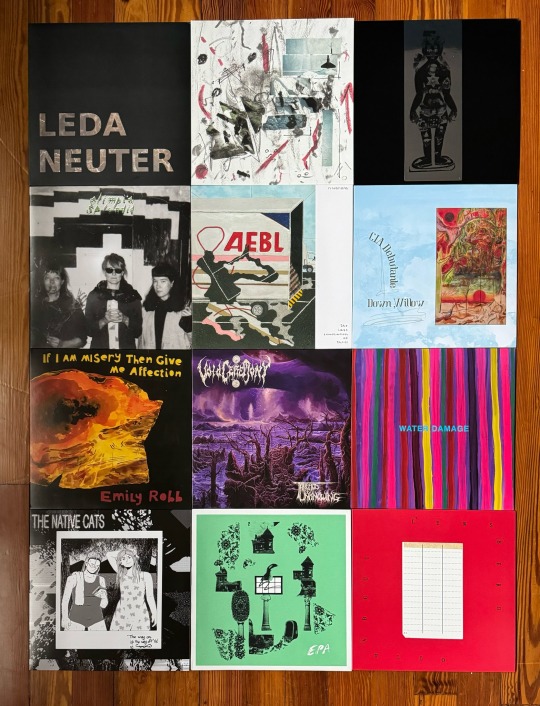
LP
Lewsberg, Out and About (12XU)
Equipment Pointed Ankh, From Inside the House (Bruit Direct Disques)
The Native Cats, The Way On Is the Way Off (Chapter Music)
Water Damage, 2 Songs (12XU)
VoidCeremony, Threads of Unknowing (20 Buck Spin)
Emily Robb, If I Am Misery Then Give Me Affection (Petty Bunco)
CIA Debutante, Down, Willow (Siltbreeze)
Olimpia Splendid, 2 (Fonal/Kraak)
Nusidm, The Last Temptation of Thrill (Bruit Direct Disques)
Incipientium, Undergång (Happiest Place)
Witness K, s/t (ever/never)
Leda, Neuter (Discreet Music)

12"/10"/7"/CS
Chrome Cell Torture, Laugh Then Lie 7" (Scarlet)
Joe Colley, Acting As If 10" (Substantia Innominata)
Disintegration, Time Moves For Me 12" (Feel It)
Life Expectancy, Decline CS (Iron Lung)
Gabi Losoncy, Lieutenant single-sided 12" (self-released)
Peg, We Know Who You Are and Everyone Is on the Lookout CS (No Rent)
Romance, Seven Inches of... 7" (self-released)
Sial, Sangkar 7" (La Vida Es Un Mus)
Slow Blink/Stomachache split CS (Hectare)
Howard Stelzer, oh calm down you're fine CS (No Rent)
Troth, Idle Easel 12" (Digital Regress)
Mark Van Fleet, Vordenal CS (Refulgent Sepulchre)
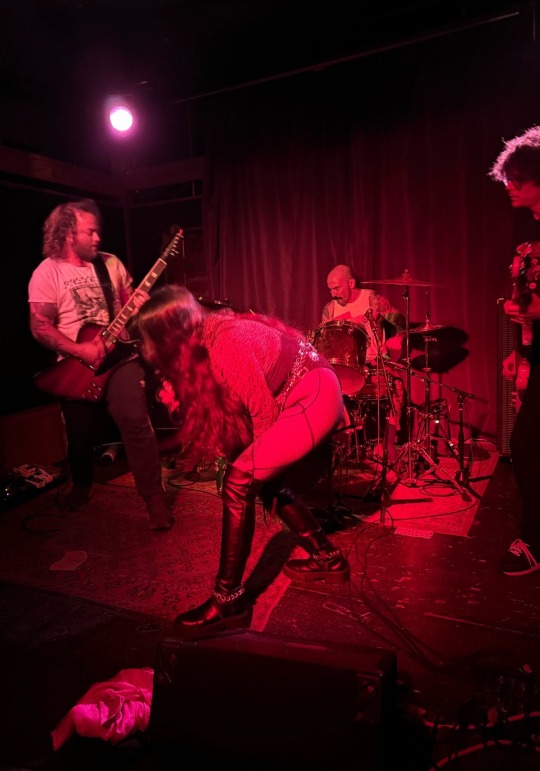
Stress Positions at the Pilot Light, Dec. 9, 2023
Shows
Bill Orcutt & Chris Corsano duo at Jackson Terminal, Knoxville, TN, April 1
Hell & My Wall at DRKMTTR, Nashville, TN, April 7
Cyberplasm, X-Harlow & FKA Ice at the Pilot Light, Knoxville, TN, May 18
Lewsberg at JJ's Bohemia, Chattanooga, TN, September 27
Stress Positions & Utopia at the Pilot Light, Knoxville, TN, December 9
Five songs favorably commented upon by my 3 y/o daughter*
*Something that happens so rarely that I try to take note when it does
Dua Lipa, "Levitating"
Martin Frawley, "Heart In Hand"
Mount Trout, "Hang Around"
Witness K, "In Knots"
The Young Senators, "Ringing Bells (Sweet Music) Part II"
#Lewsberg#Water Damage#12XU#Equipment Pointed Ankh#Nusidm#bruit direct disques#The Native Cats#Voidceremony#Emily Robb#Petty Bunco#CIA Debutante#Siltbreeze#Olimpia Splendid#incipientium#Leda#Witness K#Troth#Gabi Losoncy#Veeze#Joe Colley#The Jacka#billy woods#ELUCID#iron lung records#La Vida Es Un Mus#Best of 2023
10 notes
·
View notes
Text

It’s time to give your writing muscles a break and get those drawing ones working instead. Let’s see what you can come up with when you take your pick of one of these 3 randomly generated relics from the Magical Artifact Gen:
1. The Blue Satchel of Flames
2. The White Crystal of The Guardian
3. The Heart of Pain
Do any of these capture your imagination? Which one of these can you envision? Or perhaps…you can even see all of them!?
Whatever the case, your challenge is to draw one or more of these using whatever medium you prefer. Extra points if you can draw it in a Terrain or Evil Location. And EXTRA extra points if you can come up with a description of what it does, or how it came to be. Use whatever method or art style you wish to create your art; digital, hand-drawn, AI-generated, sculpted, knitted… Just let us know what you did. Want to use elements from another Gen? Go ahead! Just make sure that Magical Artifacts are the main focus.
You can draw as many as you like if you can manage it! When you’re done, be sure to share your artwork via the Disqus chat or on your social media accounts and include the hashtag #RangenArtChallenge so the world can view your work! Don’t forget to tag me!
2 notes
·
View notes
Text
09 DIGITAL DIARY: LAIN

Pictured above is actually me right now writing this blog post. You may have noticed the rearrangements I've made with my theme. I care to offer a bit of an explanation.
Serial Experiments: Lain. An anime released in 1998, created and co-produced by Yasuyuki Ueda, written by Chiaki J. Konaka, and directed by Ryūtarō Nakamura.
A psychological thriller with themes of identity, the series follows a young girl, Lain Iwakura, and her relationship with "the Wired" - the Internet. But, who is Lain? Who is she really? This is explored over the 13 episodes as she exhibits behaviors that suggest something else is at play.

This series predicted how we see the world today - how normalized the digital world is in our day-to-day life. (Perhaps the one thing they got wrong are the wires. Bluetooth's all the rage now! I will forever mourn headphone jacks.) It showcases multiple extremes: Lain's initial lack of digital literacy, multiple accounts of complete escapism, to consequences in children's access to online spaces. Lain dives into what it means to be posthuman; breaking the divide between real and virtual existence. No matter where you go, everyone's connected.

Serial Experiments is not conventional in terms of storytelling; it refuses to be linear, nor does it hold your hand to help you understand it. Some love it, some hate it. However, it is undeniable that this level of abstraction means discussion around the show remains active decades later. Personally, I love the feeling of piecing together the story at the end of it. Lain is a mindfuck!!! It overwhelms you with a sense of quiet dread in the best possible sense. Despite being released 25 years ago, it’s relevancy progresses alongside technology. Lain can even be seen as a cautionary tale on our relationship with the internet, where we are headed, and even where we are now. (Think: AI, Metaverse, Neuralink...) In conclusions, I changed my theme because I like Lain. That's the gist. Oh, and also the readability of my last theme was questionable.
ps. I may or may not have accidentally stayed up until unholy hours of the night finding a template for this theme and customizing it. (I got Disqus to work! Now there are actual real comments on my blog :O??????) pps. Often, I find that the more artistic, "deep", and insane a piece of media, the more lighthearted the fan-content is. Signing off with "Lain at the Gay Bar" (2008) and "lain can skate" (2023).
youtube
youtube
3 notes
·
View notes
Audio
Borja Flames - Nuevo Medievo
He has three brains, a thousand lives, past or parallel, and his name is Borja Flames. Spanish, Parisian, Burgundian, cosmonaut, we don’t know anymore. His head is that of a pope, a king, a lion, a faun or a melancholic centaur. He is well dressed, with pot holes and beard : Merovingian. We knew him in June and Jim of which he was the southern face (the northern hemisphere being Marion Cousin), a duo recently transfigured under the name of Catalina Matorral, real electronic pastoral. We saw him reshuffle his cards for the first time in 2016 with Nacer Blanco, the first album under his name, whose tipsy clocks, totems like the Tower of Pisa and bony madrigals evoked Moondog, Robert Wyatt and the Postman Cheval, one inside the other, helter-skelter. After which Rojo Vivo (2018) a blend of pale house and tenebrous preachings made us fear and pleasure and dance. Nuevo Medievo which appears today (Les disques du Festival Permanent / Murailles Music) is even more beautiful, more striking. From the very beginning, sung on tiptoe, the silvery voice with robotic effects on a synthetic bedside rug spiked with cymbals makes us feel bareheaded in a vast cabinet of stars, we are captivated. There are laser beams, oracle lyrics with vocoder. Paul Loiseau, the Morse drummer, makes the kitchen set sound like an orchestra of stoned calculators, then Borja Flames accelerates the record’s pulse with the diction of a fed-up TV news anchor before a jungle background until Marion Cousin and Rachel Langlais make everything capsize, she of saturnian vocalization, she of a strangely regulated synth. Then on, the hits fall here, there, everywhere, real ones, a shower of asteroids. Negro Negro is suave, mysterious, moving, as surprising as a kiss we no longer expect. We would gladly listen to her only but then comes Magnetismo making us giddy with joy. Then Marioneta, dry and airy as a Sign O’The Times period Prince, which one could dance to endlessly, even alone, head tucked under arm. Nuevo Medievo moves this way throughout, stiff and groovy, cerebral but exploding with dreamy tumors. Powerfully entertaining, filled with odd rhythms, computer choirs, keyboards that slide and are slippery. Nuevo Medievo is a bit reminiscent of the synth-wave scene and 80s Iberian post-punk. It also evokes lo-fi versions of Franco Battiato‘s panoramic SF hits from the album No Time No Space (far away worlds, sound research, fat refrains), Arthur Russel disco, or even Porque te vas, yes yes, Sade, Motown B-sides played at the IRCAM one evening of blunt slackness, Marvin Gaye and Tammy Terrel in a full-on slow dance under the anachronistic neon lights of a chicha bar or Blade Runner rushes with the Miami Vice original soundtrack. If Nuevo Medievo, like all of music loving cannibal Borja Flames’ records, summons a certain number of other artists, it does so to organize unexpected meetings between them, and to dissect each one in a scientific, erotic, amorous and gastronomic impulse before freeing himself from them and drawing in all the diagonals of authentically unheard features. Throw him a party. Txt : Sing Sing Translation : Cathérine Hershey Music & Lyrics by Borja Flames. Produced and arranged by Borja Flames with the collaboration of Marion Cousin, Paul Loiseau and Rachel Langlais. Recorded in Lucy-sur-Cure, Cinq-Mars La Pile and Saint-Aubin du Cormier. Mix by Manuel Duval at Grange Cavale. Mastering by Harris Newman at Grey Market. Personnel : Rachel Langlais (synths, vocals), Marion Cousin (synths, vocals, percussions), Paul Loiseau (percussions, vocals, synths), Borja Flames (vocals, guitar, synths, percussions, programming, samples).
9 notes
·
View notes
Audio
i'm getting ready to spend another friday night on wlur from 8pm until midnight. swing by or catch up with last week's show below!
no love for ned on wlur – may 12th, 2023 from 8-10pm
artist // track // album // label jale // ali // so wound // sub pop urusei yatsura // plastic ashtray // we are urusei yatsura // rocket girl hole // violet // live through this // dgc mhaol // asking for it // attachment styles // tulle mousey // the bench // my friends // winegum cheekface // popular two // it's sorted // (self-released) kate davis // monster mash // fish bowl // anti- the long blondes // once and never again // someone to drive you home // rough trade pale lips // get up and go // if you gotta go-go, go-go now- a tribute to the go-go's // sympathy for the record industry the courettes // night time (the boy of mine) // back in mono // damaged goods vera ellen // homewrecker // ideal home noise // flying nun calvin johnson // good and crazy // gallows wine // k hannah everingham // go on // between bodies // (self-released) hayden featuring feist // on a beach // are we good // arts and crafts sweeney // home song // stay for the sorrow // observable universe golden brown // busted crystal // weird choices cassette // inner islands center // the empty gesture // over the stations // bruit direct disques abdul wadud and leroy jenkins // straight ahead (excerpt) // straight ahead // red kahil el'zabar and ethnic heritage ensemble featuring dwight trible and david ornette cherry // don cherry // spirit gatherer- a tribute to don cherry // spiritmuse cvartetul de jazz paul weiner // colinda p // spirale // electrecord drew gardner featuring marco eneidi, roberto de haven and vytas nagisetty // the human abstract // the return cassette // astral spirits john carroll kirby // jubilee horns // septet // stones throw theo croker featuring ego ella may and d’leau // theo says // by the way ep // masterworks planet giza featuring saba // wyd // ready when you are // quiet note aj suede and televangel // rosicrucian rolls royce // parthian shots // fake four yaeji featuring k wata // ready or not // with a hammer // xl heather woods broderick // i want to go // labyrinth // western vinyl waterbaby // airforce blue // foam ep // sub pop evening pines // take a few steps back // it will take a long time // both worlds the lost days // half the time // in the store // speakeasy studios sf kid loco featuring katrina mitchell // love me sweet // a grand love story // yellow productions
6 notes
·
View notes